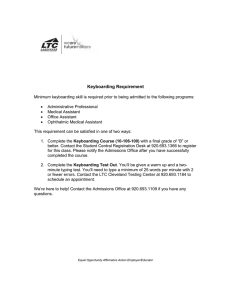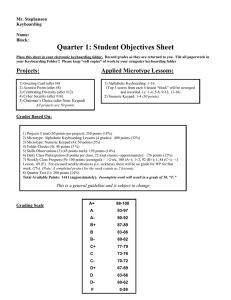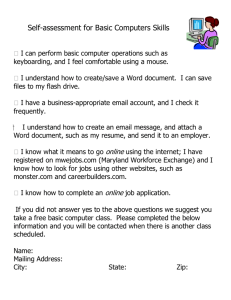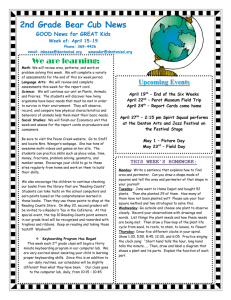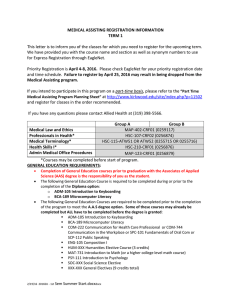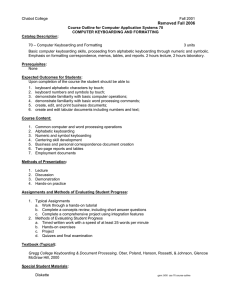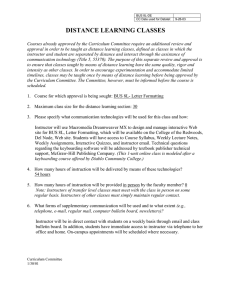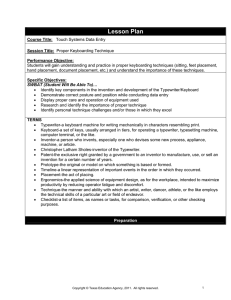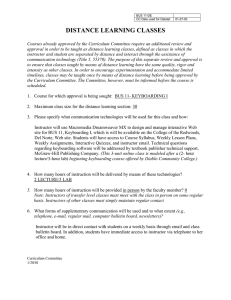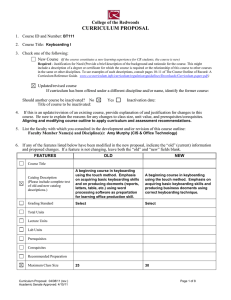– Introduction to Computers —MISSOULA THE UNIVERSITY OF MONTANA
advertisement
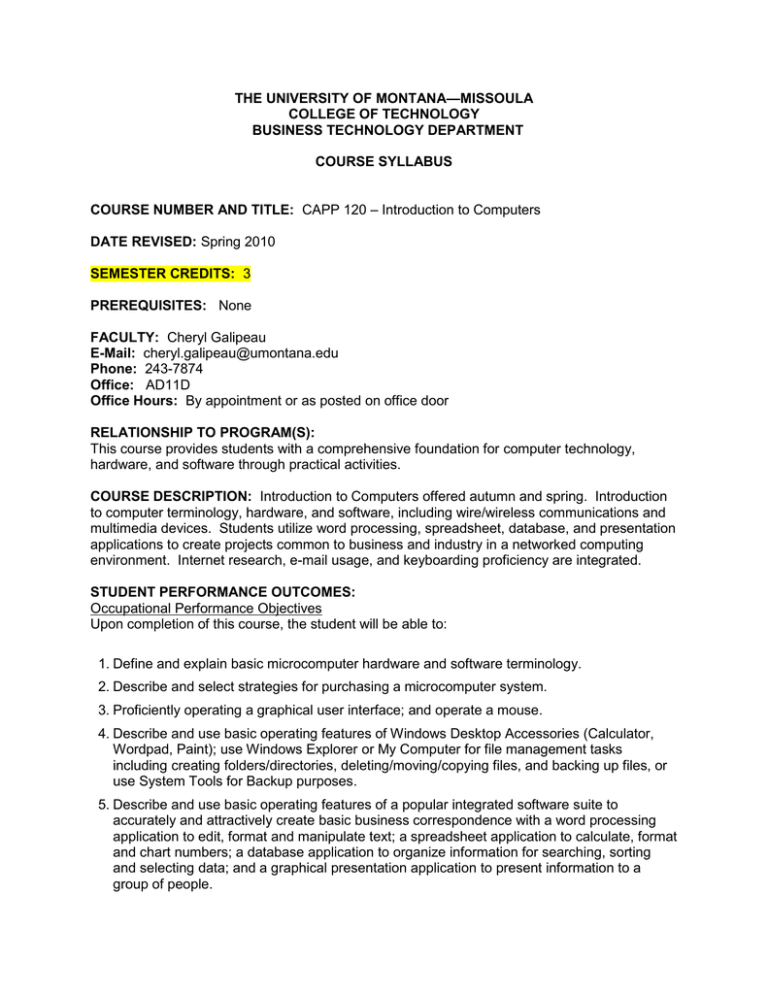
THE UNIVERSITY OF MONTANA—MISSOULA COLLEGE OF TECHNOLOGY BUSINESS TECHNOLOGY DEPARTMENT COURSE SYLLABUS COURSE NUMBER AND TITLE: CAPP 120 – Introduction to Computers DATE REVISED: Spring 2010 SEMESTER CREDITS: 3 PREREQUISITES: None FACULTY: Cheryl Galipeau E-Mail: cheryl.galipeau@umontana.edu Phone: 243-7874 Office: AD11D Office Hours: By appointment or as posted on office door RELATIONSHIP TO PROGRAM(S): This course provides students with a comprehensive foundation for computer technology, hardware, and software through practical activities. COURSE DESCRIPTION: Introduction to Computers offered autumn and spring. Introduction to computer terminology, hardware, and software, including wire/wireless communications and multimedia devices. Students utilize word processing, spreadsheet, database, and presentation applications to create projects common to business and industry in a networked computing environment. Internet research, e-mail usage, and keyboarding proficiency are integrated. STUDENT PERFORMANCE OUTCOMES: Occupational Performance Objectives Upon completion of this course, the student will be able to: 1. Define and explain basic microcomputer hardware and software terminology. 2. Describe and select strategies for purchasing a microcomputer system. 3. Proficiently operating a graphical user interface; and operate a mouse. 4. Describe and use basic operating features of Windows Desktop Accessories (Calculator, Wordpad, Paint); use Windows Explorer or My Computer for file management tasks including creating folders/directories, deleting/moving/copying files, and backing up files, or use System Tools for Backup purposes. 5. Describe and use basic operating features of a popular integrated software suite to accurately and attractively create basic business correspondence with a word processing application to edit, format and manipulate text; a spreadsheet application to calculate, format and chart numbers; a database application to organize information for searching, sorting and selecting data; and a graphical presentation application to present information to a group of people. INTRODUCTION TO COMPUTERS Page 2 6. Demonstrate correct keyboarding technique and ergonomics while using keyboarding tutorial and producing assigned documents. 7. Independently proofread and apply universal proofreading marks to make necessary editions to business documents. 8. Send and receive e-mail with attachments to/from instructor and other students. 9. Select a browser and apply research strategies to competently search the World Wide Web for assigned information. 10. Describe and apply ethical guidelines to e-mail communication, to security of computer hardware and software, and to privacy issues of computer data. 11. Illustrate and apply appropriate copyright citation to electronic and textbook references. 12. Troubleshoot and correct basic hardware/software malfunctions, such as printing errors and network errors. 13. Appraise advantages and disadvantages in new technologies such as wire and wireless communication, networking and sharing resources, and multimedia devices. STUDENT PERFORMANCE ASSESSMENT METHODS AND GRADING PROCEDURES: Production and Testing 1. Document production activities will occur on a regular, if not daily basis. Class attendance is an integral part of this course. It is the expectation that in-class production or homework assigned outside of class will be turned in when due. If you are not present, it is your responsibility to see that it is in faculty mailbox by 4:00 p.m. on the due date. Assignments are not accepted beyond the identified due date. 2. The test schedule and dates are included in the daily schedule on the syllabus. Tests will be written or produced using a computer. Makeup for tests is not offered unless faculty is notified and guidelines are identified for the individual situation. Grading Scale: 94 - 100 A 88 - 93 B 80 - 87 C 74 - 79 D Final grade will be determined by total points received on production, homework and tests in relationship to total points available. ATTENDANCE POLICY: Students are expected to come prepared for class each day and to participate in the assigned activity. In-class activities account for a substantial portion of the final grade. ACADEMIC INTEGRITY: All students must practice academic honesty. Academic misconduct is subject to an academic penalty by the course instructor and/or a disciplinary sanction by the University. All students need to be familiar with the Student Conduct Code. The Code is available for review online at http://www.umt.edu/SA/VPSA/index.cfm/page/1321. INTRODUCTION TO COMPUTERS Page 3 DISABILITY ACCOMMODATION: Eligible students with disabilities will receive appropriate accommodations in this course when requested in a timely way. Please contact me after class or in my office. Please be prepared to provide a letter from your DSS Coordinator. For more information, visit the Disability Services website at http://www.umt.edu/dss/ or call 406.243.2243 (Voice/Text). REQUIRED TEXTBOOKS: Computer Concepts, Illustrated Series, 7th Edition, (2009). J. Jamrich Parsons, D. Oja, Course Technology, Boston, MA Microsoft Office 2007 – Illustrated Brief, (2008), M. Hunt, B. Waxer, Thomson Course Technology, Boston, MA. SUPPLIES: USB jump drive is required for saving student data. COURSE OUTLINE: I. II. III. Computer Fundamentals A. Hardware and Software Terminology 1. Basic Definitions 2. System Unit a. motherboard b. central processing unit (CPU) c. memory (description/updating) 3. Processing (CPU) a. data representation b. purchasing and performance issues 4. Input/Output Devices a. types/differences b. factors influencing purchase 5. Storage Devices a. types/differences b. selecting storage devices based upon storage capacity needs 6. Software a. application software and integrated productivity suite i. other (graphics, business, educational, science, entertainment) b. operating system software and operating environments c. utilities d. netware e. licensing and software piracy 7. Types of Computers 8. Advantages/Disadvantages 9. Buying and Upgrading a Computer C. Computer Ethics Keyboarding A. Keyboarding technique B. Tutorials C. Ergonomics Windows Operating System INTRODUCTION TO COMPUTERS A. IV. V. VI. Desktop 1. Opening/Closing/Executing 2. Resizing and Scrolling Within a Window B. File Management; Windows Explorer; My Computer; Application options 1. Formatting Disks a. file allocation table (FAT) b. tracks c. sectors 2. Hierarchy or Path a. file locations b. folder/directory (root, subfolder/directory) 3. Create/Rename/Delete a Folder 4. File type, file names and file extensions 5. Launch/Save or Rename/Delete/Restore a File 6. Copy (File, Folder, Disk) 7. Status Bar 8. Version 9. Task Bar 10. Windows Explorer Views C. Functions of Settings, Control Panel, etc. 1. Time and Date Settings 2. Display Customization 3. Mouse, Keyboard 4. Add/Remove programs D. Accessories Internet and World Wide Web A. Internet 1. Introduction/History 2. Internet and Web Basics a. hypertext concept b. web browsers/servers/pages c. web addresses (URL) d. domain names e. e-commerce f. Internet and Online Service Providers g. search engines and search techniques for the Web h. Web search result evaluation and web regulations B. E-Mail Communications 1. UM based (Grizmail) e-mail a. document attachments 2. Internet based e-mail 3. Other Internet Services 4. Privacy Office Suite A. Word (word processing) B. Excel (spreadsheet) C. Access (database) D. PowerPoint (presentation) General Topics A. Professional ethics B. Communications and network 1. Wire/Wireless Page 4 INTRODUCTION TO COMPUTERS C. D. E. F. G. H. I. 2. LAN, WAN, PAN, NAN, MAN 3. Home/Business networks 4. Advantages and disadvantages Computer security a. threats b. authentication c. virus d. malware e. network and Internet security f. backup Privacy Computer crime issues Ergonomics/Health Issues Multimedia Devices a. audio b. graphics c. video Supplies for Computers and Disks Computer Industry and Careers Page 5
